A picture is worth a thousand, no, make that three hundred words. . . By Jonathan Allen
Picture books are nothing special. 300 words? Some childishly simple pictures of cute kids or funny animals? A doddle. How hard can it be? Anyone could do it. . . Picture books are EASY.

Yeah right.
I may be preaching to the choir here, but plenty of people confuse simple with easy. And, as any fule know, they are not the same at all.
Being as I am, at the simple, 'cartoony’ end of things illustration style wise, I am perhaps somewhat touchy about this.
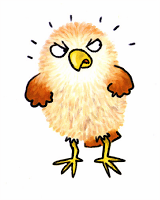 Picture books are hard! (well, good ones are)
Picture books are hard! (well, good ones are)
It's really interesting, reading the wonderful posts on this blog, to discover other authors’ and illustrators’ fascination with the mysterious process that is picture book creation.
I share their fascination. I also share the frustrations and rewards that come with the task of trying to choreograph the delicate dance performed by words and pictures in such a way that the result adds up to more than the sum of its parts. It’s certainly a deeply mysterious bit of chemistry, or possibly an equally mysterious bit of quantum mechanics mixed with a dash of chaos theory. . .
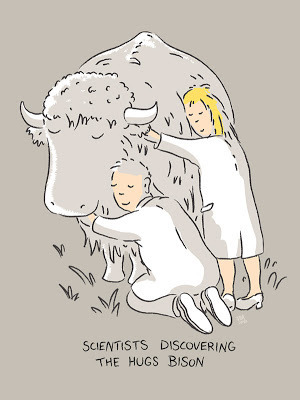
The analogy of a picture book with a piece of music, which James Catchpole posited in an earlier post is a good one. (It struck a chord with me. . . struck a chord. . get it? Oh never mind. .)
My take on it is that a good picture book is like a perfect three chord pop song. Nothing you could add would improve it, and nothing you could take away would improve it. It is perfect as it is in its simplicity. And like a perfect three chord pop song, a good picture book is a hard thing to pull off.
http://www.youtube.com/watch?v=EzJeovAiDKs
OK, more than three chords but the principle still applies ;-)
So, to put my own oar into the mix, as The Poet said (he wasn't a very good poet). . . As an author/illustrator, how do I approach picture book creation? Which comes first in my creative process, words or pictures?
Well, as I’m an illustrator who at first, only took to writing in order to have something to illustrate, (and to get bigger advances, obviously) you might be surprised to hear that in my case pictures don't always come to me first. But when they do, it goes like this -
The process starts with a character, my Potential Picture Book Protagonist. I start to draw him or her to see if that sparks any further inspiration. For me, for it to spark a fully-fledged picture book idea, a character drawing has to have the potential for a story contained within it somehow. I can’t just foist a generic story (even if I could think of one) onto a character. That never works, for me at least, and I've quite often had to drop what I thought were some great visual characters because I couldn't nail down what they would actually do. I couldn't prize a viable story out of them.
I never did know quite what to do with Small Bear here. . .
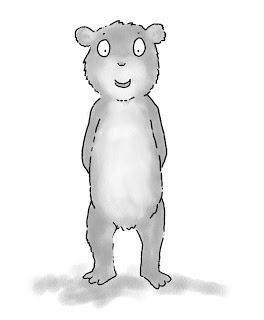
For me, a story has to emerge from, or become apparent as a kind of by-product of the picture. There has to be a fit. I have to be able to say. “Ah, so that's what was going on!”
This is best explained visually. I saw a great photo of a puffin on a website I was a member of a while back. It was walking along with one leg in the air. I thought it was really funny in an endearing sort of way and had serious children's book character potential.
(I'd post a link here but it's not on that site any more it seems)
So I drew a puffin character in a similar silly-walk sort of pose. Just for fun, I drew him looking out of the corner of his eye as if he had just noticed something happening behind him. He looked slightly pompous and silly, caught in mid stride.
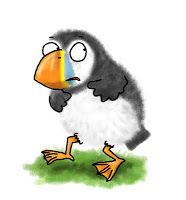
I liked the drawing very much and was sure that there was a story in there somewhere. Nothing came to me straight away so I left it to ferment for a while. I did email it to David Bennett at Boxer Books as he is a visual person and would respond if he liked it. He really liked it, which was encouraging, so I gave the drawing further consideration.
Then, an idea that was funny, had a connection to a child and parent's life experience, (this is important) and that worked really well with the drawing, came into my head.
It was this - The puffin was being followed. Not by something nasty, but by three baby gulls, who were imitating him for a silly game as he set out on his morning walk. This scenario explained puffin’s quizzical backward glance and at the same time allowed his pomposity to play a part, as the baby gulls were busy puncturing it.
“Ah, so that's what was going on!”
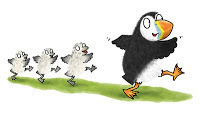
The idea developed into a book called 'Don’t Copy Me!' In which three baby gulls follow Little Puffin around, copying everything he does. The book documents his attempts to get them to stop. (I sent the photographer a copy btw).
But a picture book idea doesn't have to come from a fully formed drawing. I often find that my best ideas involve a character and a scenario, both of which arrive on the same wave of inspiration. Often as more of a concept than as a particular narrative or story. A short phrase can be the trigger, in conjunction with a drawing. The phrase can trigger the idea or loose concept, which immediately gets visualised in my head. From that, a character is drawn, roughly at first, and from that character, the character of the story itself emerges. This can all happen in about ten minutes! Then the real work starts...
My Baby Owl character, the star of my 'I’m Not' series (I’m 'Not Cute!', 'I’m Not Scared' et al) arrived in this way. His sixth book, 'I’m Not Reading!' is out now, folks. . .
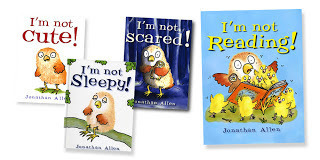
I'll document Baby Owl’s journey from fluffy blob to much loved character for you another time if I'm allowed. I’ve gone on too long as it is. . .
I hope that the above has provided some useful insight into the picture book creation process as pertains to me at least. My approach may resonate with somebody, somewhere anyway. So if you are that somebody, or even if you're not, do let me know your thoughts.
At least you now know that a picture is sometimes worth a thousand words, though three to four hundred, with the action split dynamically over twelve spreads (self ends) is preferable.
Cheers,
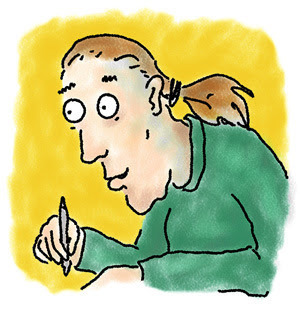 JonathanYou can find out more about guest blogger, Jonathan Allen, at his website and his blog (just click).
JonathanYou can find out more about guest blogger, Jonathan Allen, at his website and his blog (just click).

Yeah right.
I may be preaching to the choir here, but plenty of people confuse simple with easy. And, as any fule know, they are not the same at all.
Being as I am, at the simple, 'cartoony’ end of things illustration style wise, I am perhaps somewhat touchy about this.
 Picture books are hard! (well, good ones are)
Picture books are hard! (well, good ones are)It's really interesting, reading the wonderful posts on this blog, to discover other authors’ and illustrators’ fascination with the mysterious process that is picture book creation.
I share their fascination. I also share the frustrations and rewards that come with the task of trying to choreograph the delicate dance performed by words and pictures in such a way that the result adds up to more than the sum of its parts. It’s certainly a deeply mysterious bit of chemistry, or possibly an equally mysterious bit of quantum mechanics mixed with a dash of chaos theory. . .

The analogy of a picture book with a piece of music, which James Catchpole posited in an earlier post is a good one. (It struck a chord with me. . . struck a chord. . get it? Oh never mind. .)
My take on it is that a good picture book is like a perfect three chord pop song. Nothing you could add would improve it, and nothing you could take away would improve it. It is perfect as it is in its simplicity. And like a perfect three chord pop song, a good picture book is a hard thing to pull off.
http://www.youtube.com/watch?v=EzJeovAiDKs
OK, more than three chords but the principle still applies ;-)
So, to put my own oar into the mix, as The Poet said (he wasn't a very good poet). . . As an author/illustrator, how do I approach picture book creation? Which comes first in my creative process, words or pictures?
Well, as I’m an illustrator who at first, only took to writing in order to have something to illustrate, (and to get bigger advances, obviously) you might be surprised to hear that in my case pictures don't always come to me first. But when they do, it goes like this -
The process starts with a character, my Potential Picture Book Protagonist. I start to draw him or her to see if that sparks any further inspiration. For me, for it to spark a fully-fledged picture book idea, a character drawing has to have the potential for a story contained within it somehow. I can’t just foist a generic story (even if I could think of one) onto a character. That never works, for me at least, and I've quite often had to drop what I thought were some great visual characters because I couldn't nail down what they would actually do. I couldn't prize a viable story out of them.
I never did know quite what to do with Small Bear here. . .

For me, a story has to emerge from, or become apparent as a kind of by-product of the picture. There has to be a fit. I have to be able to say. “Ah, so that's what was going on!”
This is best explained visually. I saw a great photo of a puffin on a website I was a member of a while back. It was walking along with one leg in the air. I thought it was really funny in an endearing sort of way and had serious children's book character potential.
(I'd post a link here but it's not on that site any more it seems)
So I drew a puffin character in a similar silly-walk sort of pose. Just for fun, I drew him looking out of the corner of his eye as if he had just noticed something happening behind him. He looked slightly pompous and silly, caught in mid stride.

I liked the drawing very much and was sure that there was a story in there somewhere. Nothing came to me straight away so I left it to ferment for a while. I did email it to David Bennett at Boxer Books as he is a visual person and would respond if he liked it. He really liked it, which was encouraging, so I gave the drawing further consideration.
Then, an idea that was funny, had a connection to a child and parent's life experience, (this is important) and that worked really well with the drawing, came into my head.
It was this - The puffin was being followed. Not by something nasty, but by three baby gulls, who were imitating him for a silly game as he set out on his morning walk. This scenario explained puffin’s quizzical backward glance and at the same time allowed his pomposity to play a part, as the baby gulls were busy puncturing it.
“Ah, so that's what was going on!”

The idea developed into a book called 'Don’t Copy Me!' In which three baby gulls follow Little Puffin around, copying everything he does. The book documents his attempts to get them to stop. (I sent the photographer a copy btw).
But a picture book idea doesn't have to come from a fully formed drawing. I often find that my best ideas involve a character and a scenario, both of which arrive on the same wave of inspiration. Often as more of a concept than as a particular narrative or story. A short phrase can be the trigger, in conjunction with a drawing. The phrase can trigger the idea or loose concept, which immediately gets visualised in my head. From that, a character is drawn, roughly at first, and from that character, the character of the story itself emerges. This can all happen in about ten minutes! Then the real work starts...
My Baby Owl character, the star of my 'I’m Not' series (I’m 'Not Cute!', 'I’m Not Scared' et al) arrived in this way. His sixth book, 'I’m Not Reading!' is out now, folks. . .

I'll document Baby Owl’s journey from fluffy blob to much loved character for you another time if I'm allowed. I’ve gone on too long as it is. . .
I hope that the above has provided some useful insight into the picture book creation process as pertains to me at least. My approach may resonate with somebody, somewhere anyway. So if you are that somebody, or even if you're not, do let me know your thoughts.
At least you now know that a picture is sometimes worth a thousand words, though three to four hundred, with the action split dynamically over twelve spreads (self ends) is preferable.
Cheers,
 JonathanYou can find out more about guest blogger, Jonathan Allen, at his website and his blog (just click).
JonathanYou can find out more about guest blogger, Jonathan Allen, at his website and his blog (just click).
Published on March 31, 2013 00:00
No comments have been added yet.



